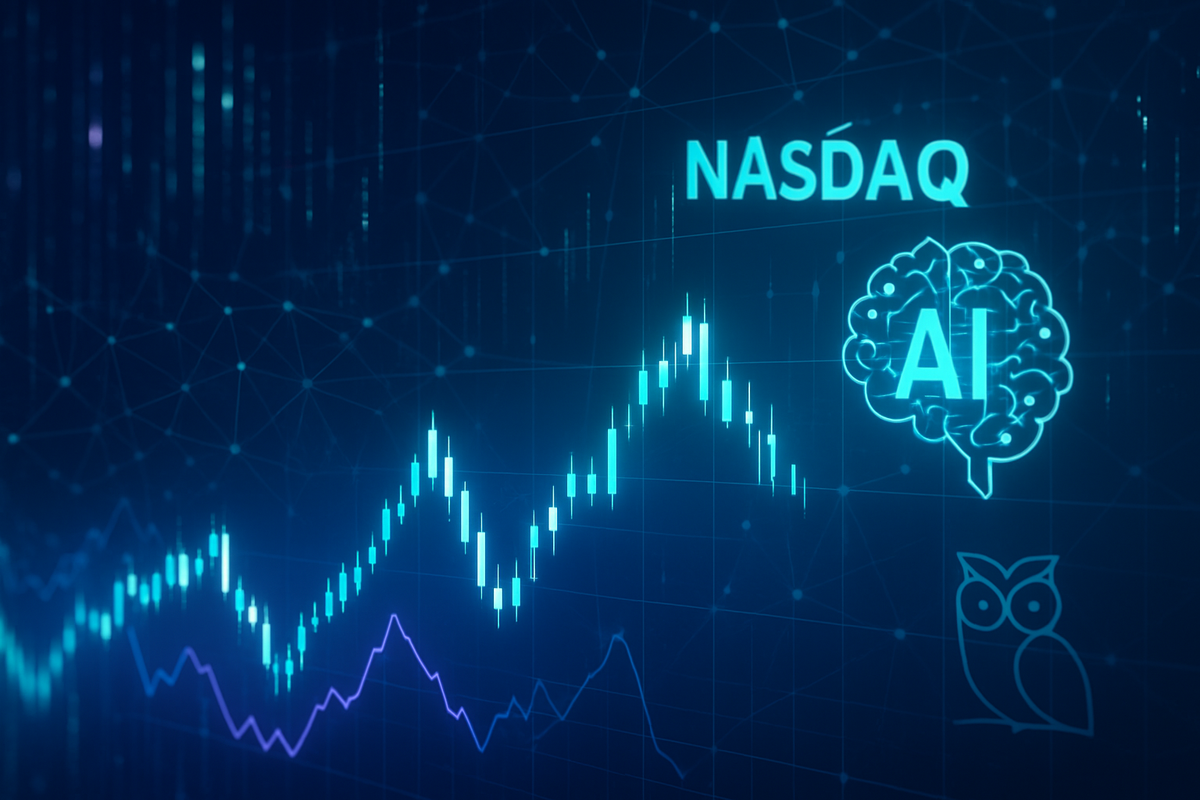
The technology sector continues to be a dominant force in the financial markets as of October 1, 2025, with its performance inextricably linked to the movements of the Nasdaq Composite Index. While artificial intelligence (AI) and semiconductor advancements fuel optimistic growth projections, recent market activity, exemplified by a significant dip in edtech giant Duolingo's (NASDAQ: DUOL) shares, highlights the underlying volatility and nuanced investor sentiment within the broader tech landscape. The sector's strong influence on major indices underscores its critical role, yet also exposes it to rapid shifts in investor confidence, particularly as valuations for some tech giants approach historic highs.
This dynamic interplay between innovation, investor enthusiasm, and cautionary concerns creates a complex environment for tech companies and the market as a whole. The Nasdaq Composite's recent modest gains, despite some daily fluctuations, reflect a market grappling with both robust technological advancements and potential economic headwinds. The spotlight on individual companies like Duolingo, experiencing notable market corrections, serves as a crucial indicator of how specific sub-sectors and growth narratives are being re-evaluated in this evolving financial climate.
Duolingo's Market Correction Amidst Broader Tech Momentum
Duolingo (NASDAQ: DUOL), a prominent name in the online language learning space, experienced a notable downturn in its market activity around October 1, 2025. On this specific day, the company's stock price saw a significant decline of 7.7%, closing at $297.14, following a 2.11% drop on the preceding day, September 30. This movement occurred even as the broader tech-heavy Nasdaq Composite Index showed modest gains, underscoring a divergence in investor sentiment for specific tech players. The trading volume for Duolingo also decreased by 23% from its average, with approximately 893,702 shares exchanged, signaling a cautious approach from investors.
The primary catalyst for Duolingo's recent turbulence appears to be concerns surrounding its user engagement. Third-party analytics reportedly indicated a 12% sequential decrease in daily active users (DAUs) during the third quarter of 2025. While September did show a slight uptick in user activity compared to August, this recovery fell short of both consensus expectations and the company's historical average quarterly DAU growth rate of 7.2% over the past five years. Analysts also observed that recent social media engagement for Duolingo seemed more driven by paid marketing efforts rather than organic user growth, raising questions about the sustainability of its user acquisition strategy.
Despite these user growth concerns and stock fluctuations, Duolingo's financial health remains robust. The company reported strong Q2 2025 earnings on August 6, 2025, with an impressive Earnings Per Share (EPS) of $0.91, significantly surpassing analyst estimates of $0.55. Revenue for the quarter also exceeded expectations, reaching $252.27 million, a substantial 41.5% increase year-over-year. With a gross margin of 72.05% and a net margin of 13.24%, Duolingo demonstrates solid profitability. However, the market's reaction suggests that future growth narratives, particularly concerning user expansion, are heavily influencing investor perception, even amidst strong current financials. Analyst ratings are varied, with some maintaining "Market Outperform" or "Overweight" ratings with price targets up to $540, citing product enhancements and strategic web-based checkout adoption, while others hold "Neutral" or "Market Perform" ratings due to the slower user growth.
Winners and Losers in a Concentrated Tech Market
The current dynamics within the technology sector present a bifurcated landscape, creating clear winners and potential losers. Companies at the forefront of the artificial intelligence (AI) revolution, particularly those involved in semiconductor manufacturing and cloud infrastructure, are undoubtedly in the winning camp. Nvidia (NASDAQ: NVDA), for example, continues to be a significant beneficiary, with strong demand for its AI chips driving robust performance and contributing to the Nasdaq Composite's modest gains even amidst broader market concerns. Other major tech players like Microsoft (NASDAQ: MSFT), Amazon (NASDAQ: AMZN), and Alphabet (NASDAQ: GOOGL, NASDAQ: GOOG), heavily invested in cloud services and AI development, also stand to gain as enterprises accelerate their digital transformation and AI adoption. These giants are leveraging their scale and R&D capabilities to integrate AI into their offerings, securing their positions at the top.
Conversely, companies like Duolingo (NASDAQ: DUOL), while financially sound, face challenges when their growth narratives, especially concerning user acquisition, fall short of elevated market expectations. The edtech sector, though benefiting from digital transformation, may experience increased scrutiny from investors looking for sustained, organic user expansion rather than relying on paid marketing. Other tech companies that might struggle are those with less differentiated products, higher customer acquisition costs, or those heavily reliant on discretionary consumer spending, which could be impacted by rising costs of capital or economic slowdowns. Startups in highly competitive niches, especially those not directly benefiting from the immediate AI boom, might also find it harder to attract investment in an environment where capital is becoming more expensive.
The market's increasing concentration in the "Magnificent 7" technology stocks—Apple (NASDAQ: AAPL), Microsoft (NASDAQ: MSFT), Nvidia (NASDAQ: NVDA), Amazon (NASDAQ: AMZN), Alphabet (NASDAQ: GOOGL, NASDAQ: GOOG), Meta Platforms (NASDAQ: META), and Tesla (NASDAQ: TSLA)—further illustrates this divide. These companies, now representing approximately 35% of the S&P 500, have been the primary drivers of recent market rallies. While their dominance reflects strong business fundamentals and innovation, it also poses a risk. Should any of these giants face significant headwinds, the ripple effect on the broader market, and particularly on the Nasdaq Composite, could be substantial, potentially turning current winners into market anchors if investor sentiment shifts rapidly.
Broader Significance: AI's Grip and Valuation Concerns
The current dynamics in the technology sector, as reflected by the Nasdaq Composite and individual company performances like Duolingo's, fit squarely into several broader industry trends. Foremost among these is the pervasive influence of Artificial Intelligence. AI, particularly generative AI and the emerging field of agentic AI, is not just a trend but a fundamental shift, driving significant investments and reshaping business operations across virtually all industries. This widespread application of AI is fueling demand for computing power and advanced software, creating a robust growth environment for semiconductor companies and cloud service providers. However, it also means that companies not directly benefiting from or integrating AI into their core strategies might find themselves falling behind, creating a competitive chasm.
The potential ripple effects of this AI-driven market are extensive. Competitors in various tech sub-sectors are compelled to accelerate their AI adoption and innovation to remain relevant. For instance, in the edtech space, companies will likely need to integrate more sophisticated AI-driven personalization and adaptive learning features to maintain user engagement, a lesson perhaps underscored by Duolingo's recent user growth challenges. Partners across the supply chain, from hardware manufacturers to software developers, are experiencing increased demand, but also pressure to innovate and scale. Regulatory bodies are also increasingly scrutinizing the ethical implications, data privacy, and potential monopolistic tendencies arising from the rapid expansion of AI, which could lead to new policies impacting data governance, content creation, and market competition.
Historically, periods of rapid technological advancement have often been accompanied by speculative market behavior. The current enthusiasm surrounding AI, while grounded in genuine innovation, draws comparisons to the dot-com bubble of the late 1990s. Analysts are noting that current U.S. equity market valuations, particularly the S&P 500's price-to-earnings (P/E) ratio, are nearing levels seen during that era. This raises concerns about potential market corrections if growth expectations are not met or if economic conditions deteriorate. The high concentration of market value in a few mega-cap tech stocks further amplifies this risk, as a downturn in one or two of these giants could have a disproportionate impact on the broader index, a scenario that investors are keenly watching as October 2025 unfolds.
The Road Ahead: Navigating Growth and Volatility
Looking ahead, the technology sector is poised for continued innovation, but also for potential strategic pivots and market re-evaluations. In the short term, companies will likely double down on AI integration, seeing it as the primary engine for growth and competitive differentiation. This will translate into increased R&D spending, strategic acquisitions of AI startups, and a push to embed AI functionalities across product lines. For companies like Duolingo (NASDAQ: DUOL), the immediate future may involve intensified efforts to revitalize organic user growth through product enhancements, community building, and potentially more diversified content offerings, rather than solely relying on paid marketing. The market will closely monitor quarterly earnings reports for signs of improved user engagement and AI-driven revenue streams across the tech landscape.
In the long term, the sector faces a complex interplay of opportunities and challenges. The persistent demand for cloud infrastructure, data services, and advanced software will continue to drive market opportunities for established players and nimble startups alike. However, rising costs of capital, driven by potential interest rate movements, could temper venture capital funding and make it harder for less profitable tech companies to sustain operations. Furthermore, geopolitical tensions and ongoing supply chain vulnerabilities remain critical challenges that could impact production, distribution, and pricing, particularly for hardware-intensive segments like semiconductors. Regulatory pressures, especially concerning data privacy, antitrust, and AI ethics, are also expected to intensify, potentially leading to new compliance burdens and operational constraints for tech giants.
Potential scenarios and outcomes for the tech sector range from continued robust growth, particularly if AI innovations translate into sustained economic productivity, to a more volatile period marked by market corrections if valuations become unsustainable or if global economic conditions worsen. Strategic adaptations, such as focusing on profitability over sheer growth, optimizing operational efficiencies, and diversifying revenue streams beyond core offerings, will be crucial for companies to thrive. The market will be looking for clear pathways to sustainable profitability and tangible returns on AI investments, rather than just speculative promises.
Comprehensive Wrap-Up: A Market at a Crossroads
In summary, the technology sector remains a powerhouse in the financial markets as of October 2025, with its performance dictating the pulse of the Nasdaq Composite Index. The key takeaway is the dual nature of the current environment: immense opportunity driven by AI innovation, coupled with significant volatility and valuation concerns. While the tech-heavy Nasdaq Composite has shown resilience and quarterly gains, the recent market activity of companies like Duolingo (NASDAQ: DUOL) underscores that even financially healthy companies can face investor skepticism if growth narratives, particularly user engagement, do not meet elevated expectations. The market is increasingly discerning, rewarding clear pathways to profitability and sustainable growth, especially in the context of rising capital costs and increased regulatory scrutiny.
Moving forward, the market will continue to be shaped by the relentless march of AI, which is fundamentally altering business models and creating new avenues for growth across software, semiconductors, and cloud services. However, investors must assess the sustainability of current valuations, especially for the "Magnificent 7" tech stocks, which hold significant sway over the broader market. The concentration risk, coupled with historical precedents of speculative bubbles, suggests a need for cautious optimism. Companies that can effectively integrate AI, demonstrate organic user growth, and navigate regulatory complexities will be best positioned for long-term success.
For investors, the coming months will require close attention to several key indicators: the pace of AI adoption and its tangible impact on corporate earnings, any shifts in Federal Reserve policy regarding interest rates, and evolving regulatory landscapes, particularly concerning antitrust and data governance in the tech space. Furthermore, watching for signs of organic user growth versus marketing-driven engagement, as highlighted by Duolingo's situation, will be crucial for evaluating the fundamental health of tech platforms. The current market signifies a crossroads where innovation meets introspection, demanding a nuanced understanding of both technological promise and financial prudence.
This content is intended for informational purposes only and is not financial advice.





